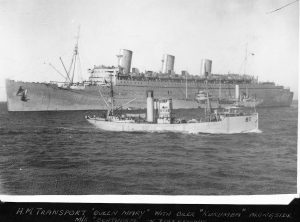- Author
- Andrews, Grahame, (Honorary Life Member)
- Subjects
- Ship histories and stories, WWII operations
- Tags
-
- RAN Ships
- None noted.
- Publication
- June 2011 edition of the Naval Historical Review (all rights reserved)
During the Falklands War in the early 1980s the warring navies of Great Britain and Argentina quickly called upon merchant shipping to pad out their naval capacity. In Great Britain, such requisitioned ships were commonly described under the interesting acronym of STUFT – Ships Taken Up From Trade. Some quickly reached a status where they might indeed have been described as STUFT, for entirely different reasons – the Atlantic Conveyor comes to mind.
Calling on merchant shipping to flesh out the official naval forces has been happening as long as navies have been used to follow political bickering with physical action.
Just a very few years before 1914 the people of Australia, through their government, bought what was effectively an all-new Navy. It was none too soon because WW1 was not far in the future and when war came the new RAN quickly realised that its purpose-built warships needed many back up ships, for minor and sometimes menial naval duties – such as minesweeping. Minesweeping is a physically demanding and dangerous work, carried in a wide range of sea conditions. What better than to co-opt fishing trawlers and the experienced small ship seamen that crew them?
In First World War naval officials expected that efforts would be made by the German Navy to interfere with both the operation of troops ships from Australia to Europe and the food and supply trade routes that worked across the Indian Ocean to Fremantle and as far as Brisbane. Early in the war the Federal government requisitioned a few seagoing tugs, certain coastal steamers and several almost new trawlers. The three ships of the Brolga class had been built in Britain between 1914 and1915 and had been bought by NSW in order to develop a state commercial fishery. These ships, of 221gross tons and about 35m in length, were Brolga, Gunundaal and Koraaga. In company with several powerful coastal tugs and other smaller coastal steam ships, these three vessels worked along the coast of NSW and into Bass Strait. Their most important mission was to search for a minefield thought to have been laid by the German raider Wolf. Near the NSW –Victorian border one mine was located on 9 October 1917 and another on 12 October. By 3 January 1918, the three ships, assisted by others, had accounted for 13 mines. This activity had been provoked by the damage to and eventual sinking of the large steamer Cumberland whose master had ignored naval instructions as to what track to follow.

Following the end of the war Brolga worked for the State Fisheries until the organization was disbanded, and was then sold commercially. She was wrecked on August 13, 1926 all 11 aboard were saved. Gunundaal likewise was returned to her NSW government owners and was, eventually, bought by the large commercial trawling company of Cam and Sons in 1923. She too was wrecked, in November 1929, near Cape Howe with all hands saved. Karaaga had a career similar to Gunundaal. Under ownership of Cam and Sons she ran aground near Bass Point on September 8 1931 and was badly damaged. She was refloated but sank the following day.
Between the wars commercial trawler expanded considerably on the eastern coast of Australia. With the state government well out of the physical picture two major companies worked the deep sea fields – Cam and Sons and Red Funnel Fisheries Ltd, which became Red Funnel Trawlers (a name still in commercial use although no fishing craft are operated by the present –2011- company).
After 1929 A.A. Murrell of Sydney operated at least two steam trawlers along the coast from Sydney. Murrell sold the 1918 built Samuel Benbow of 203grt, to Cam and Sons in 1940. For them she would have been a poor bargain as the Government of Australia commissioned her HMAS on October 5, 1939. Australia was at war again. Murrell’s other circa 1926 trawler Tongkol of 292 grt was commissioned HMAS the previous day. Murrell briefly entered the commercial fishing scene post war with the almost new New Zealand-built Pahau but soon sold her. That seems to have been the end of Murrell’s interest in commercial trawling.
Red Funnel Trawlers and Cam and Sons had a large combined fleet of trawlers, which interested the RAN, but there was also a need to maintain a fish supply to the public of New South Wales, so not all ships were taken over. There was, of course, some heavy bargaining concerning commercial imperatives and it seems likely that the best ships went to war. Among those ships taken up was one new vessel that was not a trawler although it was often so described. Patricia Cam was a wooden motor ship, built on Brisbane Water, near Gosford. She was intended to carry coal from the Cam and Sons coal wharf in Lake Macquarie, to the company’s fleet wharf in Sydney. When not in use for that she could carry other material as needed.




